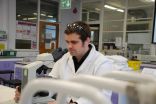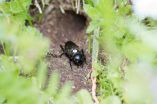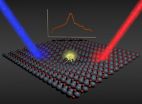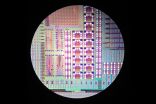(Press-News.org) SINCE its first use in the 1980s - a breakthrough dramatised in recent ITV series Code of a Killer - DNA profiling has been a vital tool for forensic investigators. Now researchers at the University of Huddersfield have solved one of its few limitations by successfully testing a technique for distinguishing between the DNA - or genetic fingerprint - of identical twins.
The probability of a DNA match between two unrelated individuals is about one in a billion. For two full siblings, the probability drops to one-in-10,000. But identical twins present exactly the same DNA profile as each other and this has created legal conundrums when it was not possible to tell which of the pair was guilty or innocent of a crime. This has led to prosecutions being dropped, rather than run the risk of convicting the wrong twin.
Now Dr Graham Williams and his Forensic Genetics Research Group at the University of Huddersfield have developed a solution to the problem and published their findings in the journal Analytical Biochemistry.
Previous methods have been proposed for distinguishing the DNA of twins. One is termed "mutation analysis", where the whole genome of both twins is sequenced to identify mutations that might have occurred to one of them.
"If such a mutation is identified at a particular location in the twin, then that same particular mutation can be specifically searched for in the crime scene sample. However, this is very expensive and time-consuming and is unlikely to be paid for by cash-strapped police forces," according to Dr Williams, who has shown that a cheaper, quicker technique is available.
It is based on the concept of DNA methylation, which is effectively the molecular mechanism that turns various genes on and off.
As twins get older, the degree of difference between them grows as they are subjected to increasingly different environments. For example, one might take up smoking, or one might have a job outdoors and the other a desk job. This will cause changes in the methylation status of the DNA.
In order to carry our speedy, inexpensive analysis of this, Dr Williams and his team propose a technique named "high resolution melt curve analysis" (HRMA).
"What HRMA does is to subject the DNA to increasingly high temperatures until the hydrogen bonds break, known as the melting temperature. The more hydrogen bonds that are present in the DNA, the higher the temperature required to melt them," explains Dr Williams.
"Consequently, if one DNA sequence is more methylated than the other, then the melting temperatures of the two samples will differ - a difference that can be measured, and which will establish the difference between two identical twins."
HRMA has some limitations, acknowledges Dr Williams. For example young twins, or twins raised in highly similar environments may not have yet developed sufficient methylation differences.
Also the technique requires a high sample quantity that might not be present at the crime scene.
"Nevertheless, we have demonstrated substantial progress towards a relatively cheap and quick test for differentiating between identical twins in forensic case work," says Dr Williams, who gives a detailed summary of the science behind the breakthrough at blog-site The Conversation.
INFORMATION:
This news release is available in German.
An individual's behaviour in risky situations is a distinct personality trait both in humans and animals that can have an immediate impact on longevity. Researchers from the Max Planck Institute for Ornithology in Seewiesen have now found differences in personality types for the first time in a population of free living field crickets. Risk-prone individuals showed a higher mortality as they stayed more often outside their burrow where they can be easily detected by predators, compared to risk averse individuals. Moreover, ...
Navigating through a cluttered environment at high speed is among the greatest challenges in biology - and it's one virtually all birds achieve with ease.
It's a feat David Williams hopes to understand.
A former post-doctoral fellow in the lab of Andrew Biewener, the Charles P. Lyman Professor of Biology, and a current post-doc at the University of Washington, Williams is the lead author of a study that shows birds use two highly stereotyped postures to avoid obstacles in flight. The study could open the door to new ways to program drones and other unmanned aerial ...
This news release is available in German.
Researchers of Karlsruhe Institute of Technology (KIT) have unveiled an important step in the conversion of light into storable energy: Together with scientists of the Fritz Haber Institute in Berlin and the Aalto University in Helsinki/Finland, they studied the formation of so-called polarons in zinc oxide. The pseudoparticles travel through the photoactive material until they are converted into electrical or chemical energy at an interface. Their findings that are of relevance to photovoltaics among others are now published ...
A Spanish-led team of European researchers at the University of Cambridge has created an electronic device so accurate that it can detect the charge of a single electron in less than one microsecond. It has been dubbed the 'gate sensor' and could be applied in quantum computers of the future to read information stored in the charge or spin of a single electron.
In the same Cambridge laboratory in the United Kingdom where the British physicist J.J. Thomson discovered the electron in 1897, European scientists have just developed a new ultra-sensitive electrical-charge sensor ...
How long is the way from the city hall to the train station? When we estimate distances, something curious happens: short distances seem longer, and long distances shorter than they really are. Similar biases occur during judgments of volume, brightness or time. Psychologists call this phenomenon Vierordt's law. Its independence of the involved sensory systems suggests that our brain possesses universal principles for the assessment of physical quantities. However, where do the characteristic estimation biases stem from? In collaboration with colleagues from Zurich, neuroscientists ...
It's a common dilemma faced by many working parents: your child has a cough or a cold, do you send them to nursery?
Researchers from the University of Bristol have, for the first time, investigated the process of decision-making that parents go through when faced with this situation. The research, published in The Journal of Public Health, reports that parents viewed coughs and colds as less serious and not as contagious as sickness and diarrhoea symptoms.
This resulted in many parents sending their child to daycare with a respiratory tract infection (RTI), which can ...
In response to an article published by Chinese scientists describing research that used gene editing technologies in human embryos, the International Society for Stem Cell Research (ISSCR) has again called for a moratorium on attempts at human clinical germline genome editing while extensive scientific analysis of the potential risks is conducted, along with broad public discussion of the societal and ethical implications. The research article, entitled "CRISPR/Cas9-mediated Gene Editing in Human Tripronuclear Zygotes," was published online on April 18 in the scientific ...
Imagine a day when scientists are able to alter the DNA of organisms in the lab in the search for answers to a host of questions. Or imagine a day when doctors treat genetic disorders by administering drugs designed to alter a patient's genome.
It may sound like science fiction, but with the development of genome-editing proteins like Cas9 and CRISPR, it could one day become science fact.
Before that happens, however, scientists must overcome a number of challenges, including how to improve the specificity of these proteins- the rate at which genome-editing proteins ...
A more intellectually demanding job may be the key to living longer after developing young-onset dementia, according to health researchers.
Degeneration of the frontal and temporal parts of the brain leads to a common form of dementia affecting people under the age of 65. It results in changes in personality and behavior and problems with language, but does not affect memory.
"[Our] study suggests that having a higher occupational level protects the brain from some of the effects of this disease, allowing people to live longer after developing the disease," said Lauren ...
An international team of scientists is calling for urgent and temperature patterns in mountain regions after compiling evidence that high elevations could be warming faster than previously thought.
Without substantially better information, people risk underestimating the severity of a number of already looming environmental challenges, including water shortages and the possible extinction of some alpine flora and fauna, according to the research team, which includes Henry Diaz and Imtiaz Rangwala from CIRES, the Cooperative Institute for Research in Environmental Sciences ...





